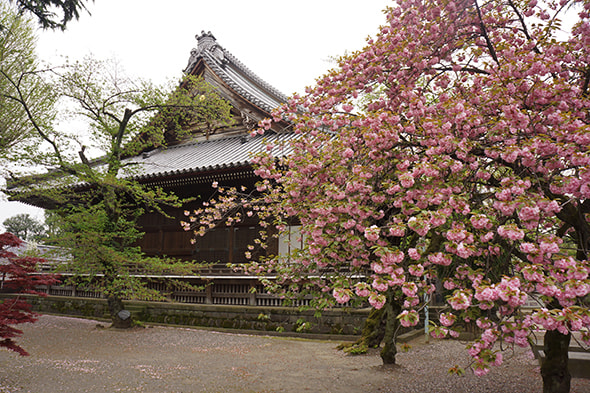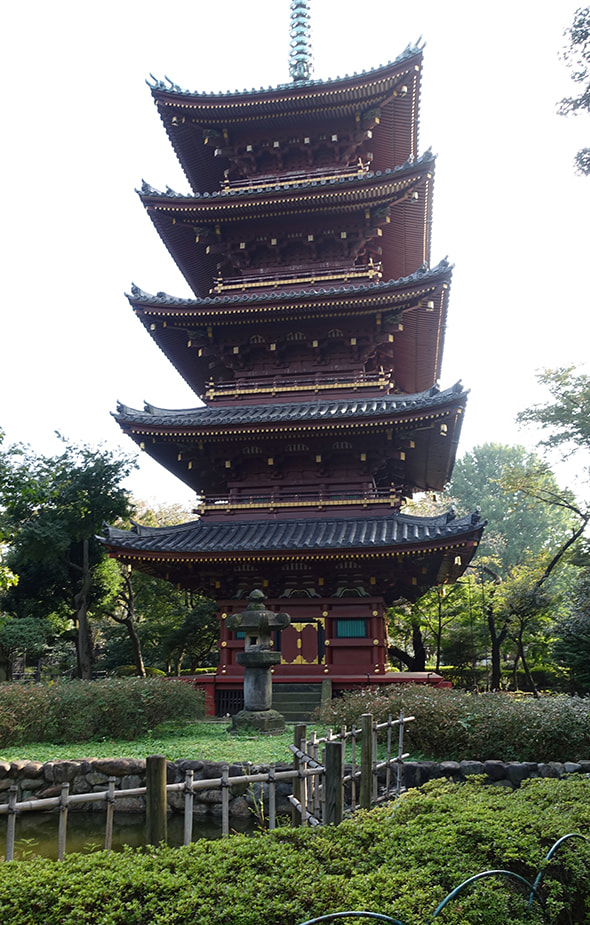

Former five-storied pagoda of Kan-eiji Temple(Ueno Zoo)
Q: However, Rinnoji is a temple, isn't it?
Urai: When a chief priest was not Rinnoji-no Miya in 1883, a petition that proposed a reconstruction of Rinnoji Temple was submitted by Kan-eiji Temple inUeno and Manganji Temple in Nikko. The petition was approved by the Imperial Family, and "Rinnoji Temple" was built in two places as Monzeki temples whose chief priests are related to the Imperial Family. It was officially approved, so the Imperial crest of the chrysanthemum is attached to the temples.
Q: Were the temples treated as shrines?
No. From the beginning, both are temples. Manganji Temple in Nikko, which is now Rinnoji Temple, has hired a Shinto priest to protect Toshogu Shrine.
Q: The most part of Kan-eiji Temple was destroyed during the Battle of Ueno that was fought between the Shogitai troops and the government troops.
Yes. The only remaining buildings are Kiyomizu Kannon-do, the five-storied pagoda and the front gate of the main hall.
Q: Looking at the original placement of the buildings, it turns out that Kan-eiji Temple's main hall was located at the area around the fountain in front of Tokyo National Museum in Ueno Park.
The main hall was set afire and destroyed after the Battle of Ueno was over. Then, Kan-eiji Temple moved to the present location.
Q: During the Second World War, Langdon Warner, an American art historian, created a list specifying places that should not be bombed. I think Kan-eiji Temple was included in the list. Was Ueno actually attacked from the air?
This is a story I heard from the former chief priest of Kan-eiji Temple. An Air Force lieutenant or colonel who bombed Ueno by a B-29 bomber came to the temple and apologized for that. Now, JR trains run below Ueno Hill. A munitions factory of Fujikura Electric Wire Corporation was located near the rail track during wartime. He excused himself that he aimed at the factory.(continued in the right column)
Q: Was Ueno a center of railroad lines at that time?
No. The first railroad line in Japan was constructed in 1872, linking Shinbashi and Yokohama. Ueno Station was built in around 1883. Since then, Ueno Station has become the gateway to the Tohoku Region. At first, I think the railroad connected to Takasaki. Then, it extended further to Aomori. Keisei Electric Railway also constructed railroad lines. Both Keisei and JR initially wanted to connect to Asakusa. However, Asakusa was flourished at that time, so it refused, insisting that it did not need any means of transportation. The two amusement districts, Asakusa and Ueno, were only connected by a subway. I think the subway was constructed in 1927.
Q: Rohan Koda wrote a novel, "Gojyu-no To," or five-storied pagoda. Was the pagoda built in the Edo Period?
It is Tennoji Temple's pagoda (Yanaka, Taito City; burnt down in 1957). Kan-eiji Temple's five-storied pagoda was built by Toshikatsu Doi, the lord of Sakura Castle in Shimousa-no Kuni (present-day Chiba Prefecture) in 1631. The pagoda was burnt down in 1639, but was reconstructed.(continued in the next page)

Former five-storied pagoda of Kan-eiji Temple(Ueno Zoo)














